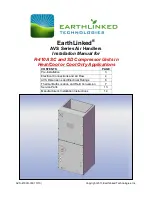
7 Commissioning
Installation manual
26
LMSEY1A09/13 + LMSEY2A19/25
Daikin LMS
4P728170-1 – 2023.03
▪ 1: Only starting.
Only starting: secondary unit controllers will start to defrost at the
same time as the primary unit controller, and all controllers can
finish in different moments.
▪ 2: Start & Stop.
Start & Stop: secondary unit controllers will start to defrost at the
same time as the primary unit controller. If one controller ends
defrosting before the others, the corresponding defrost relay is de-
energised and the dripping phase will only start when all other
controllers have finished the defrosting phase.
C1
C2
C3
C4
CM
A
A1
B
B1
B1
min.
A
B
min.
A1
B
B1
C1
C2
C3
C4
CM
dS_1 = 0
dS_2 = 1
dS_3 = 2
dS_4 = 2
d2 = 0
dS_1 = 0
dS_2 = 1
dS_3 = 2
dS_4 = 2
d2 = 1
A
Start
A1
Start not synchronised
B
End synchronised
B1
End not synchronised
C1
Controller secondary unit 1
C2
Controller secondary unit 2
C3
Controller secondary unit 3
C4
Controller secondary unit 4
CM
Primary unit controller
dS1~4
Defrost synchronisation parameters
d2
Network end defrost synchronised for primary unit
Name
Description
Default
Min.
Max.
dS_1 Network defrost synchronised
for secondary unit controller 1.
▪ 0:
No
synchronisation
performed.
▪ 1: Only at start.
▪ 2: Start & stop.
0
0
2
dS_2 Network defrost synchronised
for secondary unit controller 2.
0
0
2
dS_3 Network defrost synchronised
for secondary unit controller 3.
0
0
2
dS_4 Network defrost synchronised
for secondary unit controller 4
0
0
2
d2
Network end defrost
synchronised for primary unit
controller.
0
0
1
Local defrosting on a LMSEY unit is still possible in two ways:
▪ Manually (from app, supervisory system or user interface).
▪ With parameter “dI” (maximum interval between consecutive
defrosts) taking control. This will happen when a network
connection fault occurs that lasts longer than the "dI" parameter
setting. Therefore the "dI" parameter must always be set.
6.6
About the alarms
To check and reset alarms (error codes), see the operation manual.
7
Commissioning
CAUTION
Preliminary electrical system checks such as earth
continuity, polarity, resistance to earth and short circuit
must be carried out by using a suitable test meter by a
competent person.
WARNING
ONLY qualified persons should conduct commissioning.
Final checks for correct installation
Check that there is no air gap between unit and cold room
wall.
Check the labels of the wires connected to the door micro
switch and the door heater. The door heater wire is a live
wire, while the micro switch wire is a signal wire.
Swapping the wires will cause serious damage to the unit.
Check that all covers are closed correctly.
Check that the electrical wiring of the door micro switch,
door heater and cold room lamp are properly fixed to the
cold room panels.
Check that all the electrical wiring work is correctly
connected.
Check that all cable glands are properly tightened.
DANGER
Tripping over loose wiring can tear it loose and cause
electrocution and fire.
Final checks for correct setup
Check that the programming logic is suitable to control the
unit and the system in question.
Check that the time has been set on the controller.
Check that the time bands have been set correctly.
Check that the standard display (showing the setpoint)
has been set on the user terminal.
Check that the appropriate unit of measure has been set
for the temperature probes (°C or °F).
Test run
Connect the unit's electrical plug to the mains outlet.
Turn on the unit.
Set the cold room temperature.
Check that the setpoint of the cold room temperature is
reached.
Start defrost mode.
Check for water leaks.
Check that no alarms occur on the user interface (see
user manual).
Switch off the unit.

































